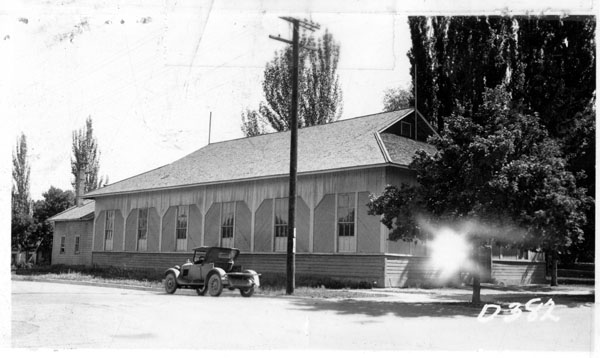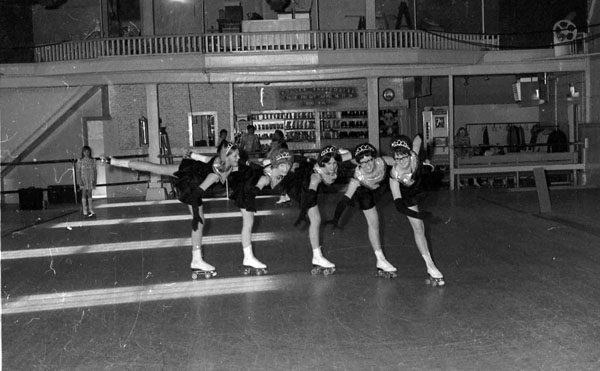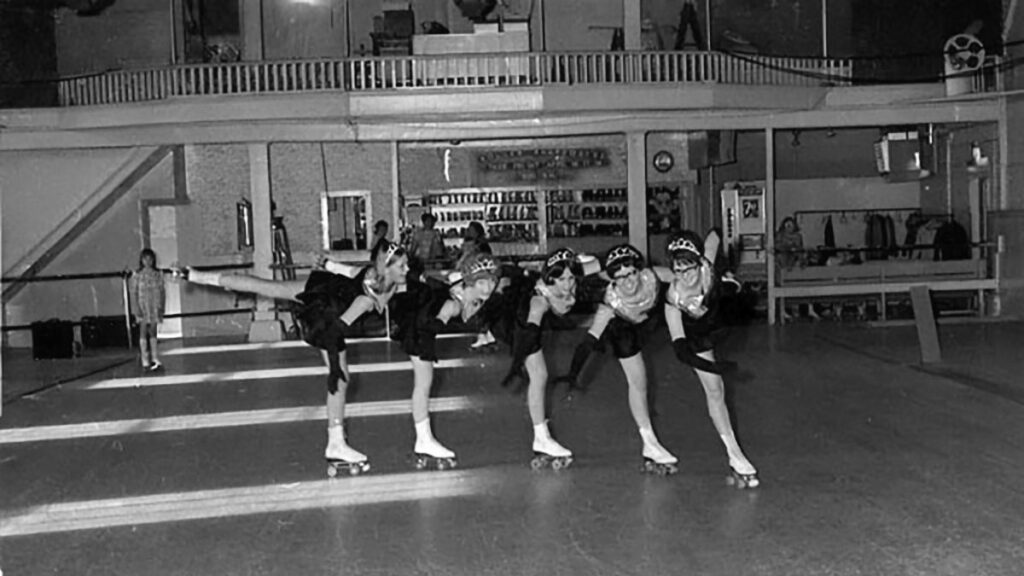By Bear River Heritage Area intern, David Giles
On the northeast corner of Center Street and First East in downtown Logan, Utah, stands an old, wood-clad building painted white. There’s no sign to name it; the only clue to its identity is the old, broken neon lighting that reads, in foot-high letters, “Skating.” Even in this state, you can tell there’s something special about the old building that makes it stand out from all the rest. This building was, in fact, the old Logan Roller Rink. Though now it sits largely empty, this was once more than just a roller rink: it was once a center of life downtown, and a major part of growing up in Cache Valley.
EARLY USE
The history of the Roller Rink begins all the way back in 1904. The plot of land it now stands on changed hands several times in the years prior, until it was sold to the Thatcher Company Orchestra—the same group that now owns the Thatcher Opera House. The building that would become the Logan Roller Rink was built for $10,000 (about $260,000 today). It opened on June 1, 1904. Tax records from a decade later, in 1913-1914, identify the building as “The Thatcher Amusement Hall,” but many people simply called it “The Bowery.” Originally, it was built as an open-air pavilion, intended for use as a dance hall (the sides were left open to help keep dancers cool in the days before air conditioning). Though it’s difficult to find records such as attendance numbers from this time period, it appears that the Bowery was a success for a while.

The Bowery struggled, despite the initial enthusiasm. According to a 2014 article in the Herald-Journal, the building was sold to the National Guard, who converted it into an armory, walling it in in the process. Even this venture was not successful, and, by 1927, the building was abandoned. It sat vacant until 1952, when R. Keith Spencer bought it. Spencer leased the building to Kay Randall, who turned it into the Logan Roller Rink that so many knew and loved.
ROLLER RINK A PLACE FOR FRIENDSHIPS
Throughout the 1950s and ‘60s, the Roller Rink was an important site for the local community. For example, a nearby junior high didn’t have a proper gym. Every so often, students would have a week of “Roller Skating Class,” held at the Roller Rink. In addition, the Roller Rink hosted “Roller Rhapsodies”—a group who would perform musical numbers on roller skates. Though both of these activities were fairly short-lived, these are not the kind of things that you would expect to happen at a mere place of entertainment, like, say, a bowling alley; these activities speak to the roller rink’s status as a cultural center.

Though Valerie Steadman attended the Roller Rink during its twilight years, her experience gives us an idea of what the Roller Rink might have been like during its heyday. “The Roller Rink was special,” she said. She described how free skating time was regularly interrupted for dances such as the Hokey-Pokey and the Limbo; both of which, she says, were a great deal more fun on roller skates. She also added that Mr. Randall, the owner, often appeared from behind the counter to join the skaters—and, apparently, he was quite skilled. He would pull tricks and stunts on his skates. Valerie sais, “it looked like [he was] ice skating.” She also remembers smaller details, like an old-fashioned glas bottle soda machine, and that the same girl who took your ticket as you walked in would also sell you the candy at the candy counter. She still speaks fondly of her time at the roller rink, and it’s not hard to see why.
Cindy Maughan, a local amateur historian, was an older teenager during the same time period. She described how the Roller Rink was important, not just as a site of recreation, but also as a meeting place. Back in the day, parents dropped their teenagers off at the roller rink at seven o’clock on weekend nights, and pick them up at midnight or later. At that time, downtown Logan was a lot more lively at night, and included a number of businesses that catered to the teenage crowd, including restaurants, arcades, and theaters. These businesses made the weekend nights more fun; and, in turn, those teenage dollars helped to keep the businesses open.

Being old enough for your parents to drop you off at the roller rink was a major milestone in a young person’s life; in fact, Cindy said that “most of the coming-of-age of Logan [happened] in that building.” As a place for teenagers to hang out, it also became a precious opportunity to meet kids from other high schools in the valley. Both Cindy and Valerie talked about meeting your crush there, making it one of the few places where such an interaction was acceptable, not to mention possible.
The Rink also developed its own social structure and hierarchy. For example, only the “cool kids” could sit on the stairs leading up to the balcony overlooking the rink itself. Girls who needed to share secrets or compare notes could duck into the tiny two-stall women’s restroom. Jockeying for positions next to your crush during the Snowball or the Hokey Pokey was a special ritual conducted multiple times a night.
And, most of all, the roller rink became a place to meet new people and to form lasting friendships. Cindy told the touching story of a young man, a Logan local, who was drafted into the army, and was unexpectedly killed shortly after being deployed. His old friends, each of whom he left in Logan, held a candlelight vigil in the roller rink.
NEW PURPOSE
Unfortunately, the Logan Roller Rink—like so many other things in life—came to an end. With the building of the Cache Valley Mall in 1976, commerce started to move away from downtown, causing businesses there to struggle. The rink limped along until the mid-nineties, when it closed for good. R. Keith Spencer, the owner of the building, finally sold it in 2005. Without a business to maintain it, the building began to decay. The windows broke and the neon lighting fell apart; the paint began to peel and flake off; and birds and animals nested inside. Mr. Spencer passed away in 2013; Kay Randall, who had owned and managed the Rink itself, followed shortly thereafter in 2014.
In 2009, a new owner purchased the building and renovated it. It was cleaned up, repainted, and brought up to modern standards inside.
It seems unlikely that the old building will be resurrected as a roller rink anytime soon. Report are that the building is used for private events for friends and family, as well as occasional meetings of the Logan Chinese Baptist church. Though many people would love to see the building open to the public again, this may be the single best use of the building for now. The building’s odd location off Main, coupled with its rather severe lack of parking, would make it difficult for a business to operate there.
The fact remains that many people’s lives were changed by their experiences at the Logan Roller Rink. Cindy Maughan, for example, met her future husband there; and Valerie Steadman and her children still find places to skate. Even though there won’t be the gym classes, the dances, or the roller rhapsodies again, the historic building has been preserved in its original place, and will mean something just as significant to a new generation of people enjoying it in a new way.

